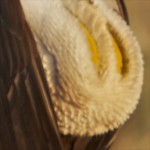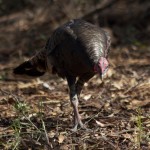We care a lot about the sounds that sage-grouse make here in the Patricelli lab. Much of our effort has been in understanding how males make the bizarre collection of noises they use on the lek, what do those sounds mean for females, and how do human noise impacts affect wildlife. Among the sounds we’ve become increasingly interested in are the “swish” notes that introduce the rest of the display. These notes are made by the male rubbing his wings against specialized breast feathers, creating sounds that is reminiscent of walking in noisy corduroy pants. Looking at the spectrogram on the computer, the swishes are fairly broadband, but with surprisingly concentrated and variable frequency structure within the broadband noise. You can hear this noise in some of our videos (for example: here, here, and here).
Sage-grouse certainly are not the only kind of animal to make noises by rubbing two parts of their body together, nor it turns out, even the only one to vary the frequency of these mechanically produced sonations. Natasha Mhatre and colleagues recently reported that tree crickets can adjust the resonance frequency of their chirping stridulations.Their wings have multiple natural vibrational modes, and the crickets have the ability to shift the frequency at which the wings are vibrating. This ability to adjust must make for a much more complicated courtship process, since females may not be able to use the simple rule “lower frequency = bigger, better male”.
Many bird species also make sounds with their feathers. One of our collaborators on our sage-grouse work, Kim Bostwick, a curator at the Cornell Laboratory of Ornithology, also works on manakin species that make sounds by rubbing or hitting their wings together. It is a really interesting system, since the relationships between these birds are known, and it is possible to see how these really specialized behaviors and structures have evolved. She recently published on some of the skeletal specializations that these birds have. She is also putting together a really beautiful website that explains her work on these birds. I hope you will check it out: singingwings.org.


